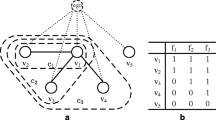Abstract
Mobile social networks, which consist of mobile users who communicate with each other using cell phones, are reflections of people’s interactions in social lives. Discovering typed communities (e.g., family communities or corporate communities) in mobile social networks is a very promising problem. For example, it can help mobile operators to determine the target users for precision marketing. In this paper we propose discovering typed communities in mobile social networks by utilizing the labels of relationships between users. We use the user logs stored by mobile operators, including communication and user movement records, to collectively label all the relationships in a network, by employing an undirected probabilistic graphical model, i.e., conditional random fields. Then we use two methods to discover typed communities based on the results of relationship labeling: one is simply retaining or cutting relationships according to their labels, and the other is using sophisticated weighted community detection algorithms. The experimental results show that our proposed framework performs well in terms of the accuracy of typed community detection in mobile social networks.
Similar content being viewed by others
References
Wasserman S, Faust K. Social Network Analysis. Cambridge, UK: Cambridge University Press, 1994.
Scott J. Social Network Analysis: A Handbook (2nd edition). London, UK: Sage Publications, 2000.
Dong Z, Song G, Xie K, Wang J. An experimental study of large-scale mobile social network. In Proc. the 18th International Conference on World Wide Web (WWW2009), Madrid, Spain, April 20-24, 2009, pp.1175–1176.
Wang Y, Cong G, Song G, Xie K. Community-based greedy algorithm for mining top-K influential nodes in mobile social networks. In Proc. the 16th ACM SIGKDD International Conference on Knowledge Discovery and Data Mining (KDD2010), Washington, DC, USA, July 25-28, 2010, pp.1039–1048.
Zheng V W, Zheng Y, Xie X, Yang Q. Collaborative location and activity recommendations with GPS history data. In Proc. the 19th International Conference on World Wide Web (WWW2010), Raleigh, NC, USA, April 26-30, 2010, pp.1029–1038.
Ministry of Industry and Information Technology of the People’s Republic of China. http://www.miit.gov.cn/.
Girvan M, Newman M E J. Community structure in social and biological networks. PNAS, 2002, 99(12): 7821–7826.
Newman M E J. Detecting community structure in networks. The European Physical Journal B, 2004, 38(2): 321–330.
Hui P, Xu K, Li V O K, Crowcroft J, Latora V, Lio P. Selfishness, altruism and message spreading in mobile social networks. In Proc. IEEE INFOCOM Workshops 2009, Rio de Janeiro, Brazil, April 19-25, 2009, pp.1–6.
Lafferty J, McCallum A, Pereira F. Conditional random fields: Probabilistic models for segmenting and labeling sequence data. In Proc. the 18th International Conference on Machine Learning (ICML 2001), Williams College, Williamstown, MA, USA, June 28-July 1, 2001, pp.282–289.
Jensen D, Neville J, Gallagher B. Why collective inference improves relational classification. In Proc. the 10th ACM SIGKDD International Conference on Knowledge Discovery and Data Mining (KDD2004), Seattle, WA, USA, Aug. 22-25, 2004, pp.593–598.
Macskassy S A, Provost F. Classification in networked data: A toolkit and a univariate case study. The Journal of Machine Learning Research, 2007, 8: 935–983.
Ng A Y, Jordan M I. On discriminative vs. generative classifiers: A comparison of logistic regression and naive Bayes. In Advances in Neural Information Processing Systems 14 (NIPS 2001), Vancouver, British Columbia, Canada, Dec. 3-8, 2001, pp.841–848.
Lu Q, Getoor L. Link-based classification. In Proc. the 20th International Conference on Machine Learning (ICML 2003), Washington, DC, USA, Aug. 21-24, 2003, pp.496–503.
Besag J. Statistical analysis of non-lattice data. Journal of the Royal Statistical Society, Series D (The Statistician), 1975, 24(3): 179–195.
Getoor L, Taskar B. Introduction to Statistical Relational Learning. Cambridge, USA: The MIT Press, 2007.
Pearl J. Probabilistic Reasoning in Intelligent Systems: Networks of Plausible Inference. San Francisco, USA: Morgan Kaufmann, 1988.
Murphy K P, Weiss Y, Jordan M I. Loopy belief propagation for approximate inference: An empirical study. In Proc. the 15th Conference on Uncertainty in Artificial Intelligence (UAI 1999), Stockholm, Sweden, July 30-Aug. 1, 1999, pp.467–475.
Fortunato S. Community detection in graphs. Physics Reports, 2010, 486(3-5): 75–174.
Neville J, Jensen D. Iterative classification in relational data. In Proc. the AAAI-2000 Workshop on Learning Statistical Models from Relational Data (SRL 2000), Austin, TX, USA, July 30-Aug. 3, 2000, pp.13–20.
Sen P, Getoor L. Link-based classification. Technical Report CS-TR-4858, Department of Computer Science, University of Maryland, 2007.
Rosvall M, Bergstrom C T. Maps of random walks on complex networks reveal community structure. PNAS, 2008, 105(4): 1118–1123.
Lancichinetti A, Fortunato S. Community detection algorithms: A comparative analysis. Physical Review E, 2009, 80(5): 056117.
Newman M E J, Girvan M. Finding and evaluating community structure in networks. Physical Review E, 2004, 69(2): 026113.
Danon L, Díaz-Guilera A, Duch J, Arenas A. Comparing community structure identification. Journal of Statistical Mechanics: Theory and Experiment, 2005: P09008.
Author information
Authors and Affiliations
Corresponding author
Additional information
This work was partially supported by the Fundamental Research Funds for the Central Universities of China, the National Natural Science Foundation of China under Grant No. 60905029, and the Beijing Natural Science Foundation under Grant No. 4112046.
Electronic Supplementary Material
Below is the link to the electronic supplementary material.
Rights and permissions
About this article
Cite this article
Wan, HY., Lin, YF., Wu, ZH. et al. Discovering Typed Communities in Mobile Social Networks. J. Comput. Sci. Technol. 27, 480–491 (2012). https://doi.org/10.1007/s11390-012-1237-9
Received:
Revised:
Published:
Issue Date:
DOI: https://doi.org/10.1007/s11390-012-1237-9




